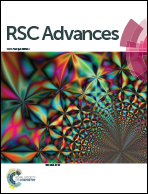A mechanistic study on the effect of a surface protecting agent on electrocrystallization of silver nanoparticles
Abstract
Cyclic voltammetry and chronoamperometry at characteristic potentials were employed to unravel the mechanism of electrocrystallization of silver nanoparticles (AgNPs) from their aqueous solution in the presence and absence of surface protecting agent tetrabutylammonium tetrafluoroborate (TBABF4). The electrocrystallization parameters viz. initial current density (j0), decay constant (τ), diffusion coefficient (D) of Ag(I), number of active sites (N0) and nucleation rate (a) were calculated by fitting the experimentally obtained current transients with the calculated current transients using a hybrid genetic algorithm (HGA). The theoretical currents were calculated from three popular electrocrystallization models viz. Scharifker and Mostany (SM), Sluyters-Rehbach, Wijenberg, Bosco and Sluyters (SRWBS) and Heerman and Tarallo (HT). Each of the three models fitted well by the HGA with the potentiostatic current transients observed at different potentials, both in the absence and in the presence of TBABF4 with residual sum of squares (∼10−7) and reduced χ2 (∼10−10). However, the electrocrystallization parameters were distinctly different in each of the three models. Principal component analysis of the calculated parameters i.e. D, NS and aN0 showed the absence of any correlation among the electrocrystallization parameters derived from the Scharifker and Hills (SH), SM, SRWBS and HT models. Further, the actual nuclei densities of the AgNPs, both in the presence and the absence of TBABF4, were found to be significantly higher than the predicted values from any of these models. Since these models are based on different empirical assumptions, one needs be careful in attaching any extra significance to the numerical values of j0, τ, D, N0, “a” of any system only based on the quality of fitting. From the present data, it was conclusively proved that the surface protecting agent slowed down the kinetics of electrocrystallization due to introduction of a higher activation overpotential at the electrode–electrolyte interface and subsequent decreases in the number of nuclei on the electrode surface in the presence of TBA+ ions, irrespective of the model.


 Please wait while we load your content...
Please wait while we load your content...